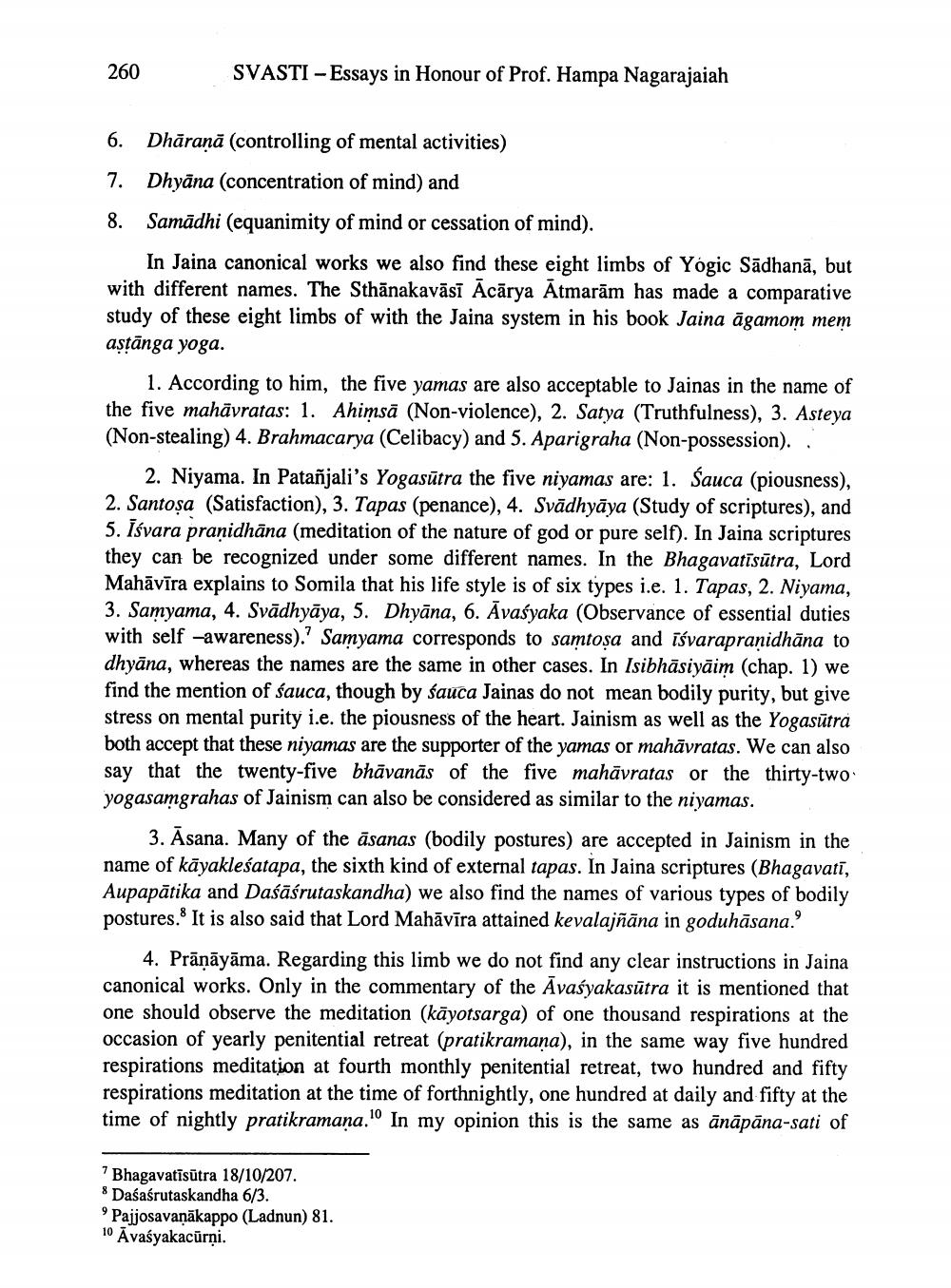________________
260
SVASTI -Essays in Honour of Prof. Hampa Nagarajaiah
6. Dhāraṇā (controlling of mental activities) 7. Dhyāna (concentration of mind) and
8.
Samādhi (equanimity of mind or cessation of mind).
In Jaina canonical works we also find these eight limbs of Yogic Sādhanā, but with different names. The Sthānakavāsī Ācārya Atmarām has made a comparative study of these eight limbs of with the Jaina system in his book Jaina āgamom mem astānga yoga.
1. According to him, the five yamas are also acceptable to Jainas in the name of the five mahāvratas: 1. Ahimsā (Non-violence), 2. Satya (Truthfulness), 3. Asteya (Non-stealing) 4. Brahmacarya (Celibacy) and 5. Aparigraha (Non-possession)...
2. Niyama. In Patañjali's Yogasūtra the five niyamas are: 1. sauca (piousness), 2. Santosa (Satisfaction), 3. Tapas (penance), 4. Svādhyāya (Study of scriptures), and 5. īśvara pranidhāna (meditation of the nature of god or pure self). In Jaina scriptures they can be recognized under some different names. In the Bhagavatīsütra, Lord Mahāvīra explains to Somila that his life style is of six types i.e. 1. Tapas, 2. Niyama, 3. Samyama, 4. Svādhyāya, 5. Dhyāna, 6. Āvasyaka (Observance of essential duties with self -awareness).' Samyama corresponds to samtosa and īśvarapranidhāna to dhyāna, whereas the names are the same in other cases. In Isibhāsiyāim (chap. 1) we find the mention of sauca, though by sauca Jainas do not mean bodily purity, but give stress on mental purity i.e. the piousness of the heart. Jainism as well as the Yogasutra both accept that these niyamas are the supporter of the yamas or mahāvratas. We can also say that the twenty-five bhāvanās of the five mahāvratas or the thirty-two yogasamgrahas of Jainism can also be considered as similar to the niyamas.
3. Āsana. Many of the āsanas (bodily postures) are accepted in Jainism in the name of kāyakleśatapa, the sixth kind of external tapas. In Jaina scriptures (Bhagavatī, Aupapātika and Daśāśrutaskandha) we also find the names of various types of bodily postures. It is also said that Lord Mahāvīra attained kevalajñāna in goduhāsana.
4. Prāņāyāma. Regarding this limb we do not find any clear instructions in Jaina canonical works. Only in the commentary of the Āvasyakasūtra it is mentioned that one should observe the meditation (kāyotsarga) of one thousand respirations at the occasion of yearly penitential retreat (pratikramana), in the same way five hundred respirations meditation at fourth monthly penitential retreat, two hundred and fifty respirations meditation at the time of forthnightly, one hundred at daily and fifty at the time of nightly pratikramana.'' In my opinion this is the same as ānāpāna-sati of
7 Bhagavatīsūtra 18/10/207. 8 Daśaśrutaskandha 6/3.
Pajjosavaņākappo (Ladnun) 81. 10 Āvaśyakacūrņi.




